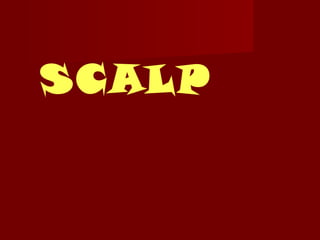
SCALP Structure and Layers
- 1. SCALP
- 2. SCALP The soft tissue which covers the calvaria of the skull
- 3. EXTEND OF SCALP • Anteriorly: Supra orbital margin • Posteriorly: External occipital protuberance & superior nuchal line • On each side: Zygomatic arch
- 4. SCALP CONSIST OF FIVE LAYERS S -Skin C -Connective tissue A -Aponeurosis (galea aponeurotica) L -Loose areolar tissue P -Pericranium
- 5. Skin (First layer) Thick and hairy Firmly attached to the epicranial aponeurosis through dense connective tissue. Abundance sweat & sebaceous glands present Sebaceous cyst are common.
- 6. Dense Connective tissue(2nd layer) Fibrous and dense, containing blood vessels and nerves. Binds skin to subjacent aponeurosis Wounds bleed profusely as blood vessels are prevented from retraction by fibrous tissue. Bleeding is stopped by applying pressure against the bone. Subcutaneous hemorrhage are not extensive since tissue is dense. Inflammation cause little swelling but are much painful.
- 7. Occipitofrontalis & its aponeurosis(3rd layer) Anteriorly a pair of frontal bellies (frontalis) and posteriorly a pair of occipital bellies (occipitalis) of occipitofrontalis muscle.
- 8. Occipitofrontalis & its aponeurosis(3rd layer) Frontal belly has no bony origin. Occipital belly originate from lateral 2/3 of superior nuchal line. Nerve supply ? Action? Aponeurosis (galea aponeurotica) it connects occipitalis and frontalis. It gaps if cut transversely and should be stitched.
- 9. Loose areolar tissue (4th layer) Extends anteriorly into the eyelids because frontalis has no bony attachment Posteriorly to superior nuchal line Called dangerous layer of scalp-emissary veins open here and carry any infections inside the brain (venous sinus)
- 10. Loose areolar tissue (4th layer) Bleeding cause generalized swelling of scalp. • Bleeding lead to black eye. • Fourth layer also forms safety valve haematoma during fracture of cranial vault. Caput succedaneum is temporary swallen of scalp in new born.
- 11. Pericranium (5 layer)th Is the periosteum of skull Loosely attached to surface of bone but is firmly adherent to the sutures Injury deep to it produce localised swelling which take the shape of bone (cephalohaematoma)
- 12. BLOOD SUPPLY AND NERVE SUPPLY OF SCALP
- 13. VENOUS DRAINAGE OF SCALP Retromandibular vein Facial Vein External jugular vein
- 15. Presented by Kishwor Bhandari. The End.
